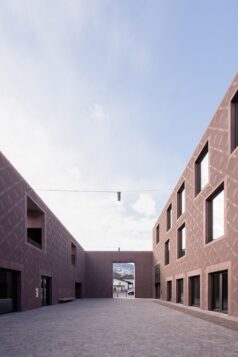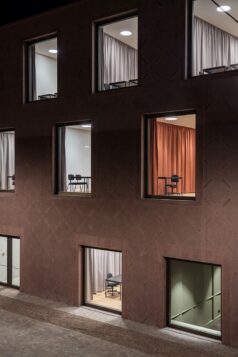
In Bressanone (Bolzano, Italy), oldest city in Tyrol, the economic center of the Isarco Valley and the third largest city in South Tyrol, construction is complete on “Wunderkammer” (Chamber of Wonders): the Music School of Bressanone, an institution founded in 1961 and a landmark for the entire region.
The new headquarters, which welcomes over 1,000 students, is located in the northern area of the city, close to its ancient core. The project represents the new gateway to the city, a focal point of the Priel area. The project is an integral part of a larger plan, which includes the construction of a new underground public carpark on two levels to the north, with an urban crossing park on the roof. Its southern counterpart will feature a square with an additional underground level of public parking, which connects the Brenner state road – an ancient artery connecting Austria and Italy – with the municipal swimming pool and the historic city.
A hub for underground vehicular flows and pedestrian paths at all levels, as well as the north face of the future square, surrounded to the east by the climbing wall and the municipal swimming pool, the School of Music guarantees the appropriate spatial alignment to complete the new urban plan and resolves the orographic dilemma and the differences in altitude.
Located in the western part of the entire project, the school is spread over three floors above ground and a portion of the basement. To mitigate the impact on the city skyline, the top floor is set back from the line of the external facades, obtaining an optical effect that dissolves the perception of the building. The elevations are also conceived as wall faces, whose treatments change in relation to the context, in order to resonate harmoniously with the surrounding buildings.
The enclosure, which together with the volume of the school, surrounds the large collective space of the courtyard located to the east, and is configured as a two-story volume, within which the vertical distribution elements and city services are located. In this way, the differences in elevation are resolved, ensuring visual continuity between the square and the future Priel Park, while the depth of field toward the mountains to the north and south of the area remains uninterrupted.
Accessible to the public at all times, the courtyard houses a series of connecting devices and collective services, such as kiosks, warehouses and vertical distribution elements.
One of the distinctive features of the project is the “garden of music,” a finely decorated open-air room, inside the enclosure and yet outside the volume of the school, which dissolves the boundary between inside and outside. In direct relation to the garden and the future Piazza Priel, the entrance to the school and the large foyer with its shape for immediate orientation, are located to the south of the building. The administration, entirely located on the ground floor, also faces the same direction. Moreover, both the functional and spatial organization modulate the degree of independence between the school and the hall with a stage, housed on the ground floor and partially embedded in the ground, designed to host public concerts.
On the ground, first and second floors, there are 29 music rooms. The stairs and connecting elements, designed as a continuous and choreographic system starting from the entrance foyer, lead through all levels of the school.
The rooms and distribution elements, as well as the large central corridor from which the classrooms branch off, are illuminated by a large skylight that allows natural light to pass through the entire volume thanks to a system of double heights, and were designed as spaces of aggregation, and as waiting, study and meeting areas for students.
A basement, accessible from the school’s freight elevator, a public lift and a staircase to the north-east of the enclosure, house technical and storage rooms for the school and the municipality of Bressanone. A tunnel below the courtyard represents the future connection with the roads provided by the Priel carpark.
Entirely built in exposed reinforced concrete, the building, devoid of coatings, presents a correspondence between structure and architecture. By adding red porphyry aggregates and pigments (red at 3% and black at 2.5%) to the concrete, the complex achieves a color and texture that blends with the customs and traditional materials.
The only treatment given to the surfaces to make them vibrant in natural light is the manual bush-hammering of the whole building, except for the frames coinciding with the openings and for the courtyard, entirely hammered by hand with a motif taken from the typical local textures. A finish of great simplicity, it reinterprets the precious decorations that dot the heart of the city in a contemporary key.
The project team included general contractor Unionbau and architectural firm Carlana Mezzalira Pentimalli.











 Join our thriving community of 70,000+ superintendents and trade professionals on LinkedIn!
Join our thriving community of 70,000+ superintendents and trade professionals on LinkedIn! Search our job board for your next opportunity, or post an opening within your company.
Search our job board for your next opportunity, or post an opening within your company. Subscribe to our monthly
Construction Superintendent eNewsletter and stay current.
Subscribe to our monthly
Construction Superintendent eNewsletter and stay current.